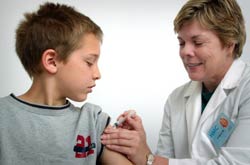H1N1 flu had significant impact in life years lost
April 2010 | Volume 9, Issue 2

Photo by James Gathany, CDC
Scientists propose measuring H1N1 impact
in life years lost. Its impact was greater than
perceived due to deaths of a disproportionate
number of children and young adults.
Some thought reaction to the 2009 H1N1 threat was overblown by the media, pharmaceutical companies and public health organizations. But due to the disproportionate number of children and young adults that died as a result of this strain of flu, some researchers have determined that the H1N1 impact was greater than perceived. They propose that life years lost is a more accurate measure of the impact of a public health crisis than mortality numbers without context.
With three colleagues, Fogarty scientists Dr. Cecile Viboud and Dr. Mark Miller analyzed age-group mortality data applied to the estimated deaths from this pandemic and they published their conclusions in PLoS Currents: Influenza. The findings are conservative because more waves of this flu are expected, along with more deaths, in 2010 and possibly beyond.
According to the scientists, the true toll of this pandemic is between 334,000 and 1,973,000 years of life lost, putting its impact somewhere between a tough seasonal flu epidemic and the pandemic of 1968-69 that was called the "Hong Kong flu."
Concerns that the true severity of the 2009 influenza pandemic was underestimated led to this project. The World Health Organization in particular was criticized for responding too forcefully, issuing overzealous vaccine recommendations that put people at risk of unknown side-effects. Adding to that argument is recent news that out of 229 million doses of H1N1 vaccine that were made, approximately 71.5 million are about to expire and may be destroyed.
The authors affirm the recommendation to include the pandemic H1N1 virus antigen in the next seasonal vaccine formulation and urge government and public health organizations to be vigilant, and continue vaccination efforts and other preparations.
More Information
To view Adobe PDF files,
download current, free accessible plug-ins from Adobe's website.